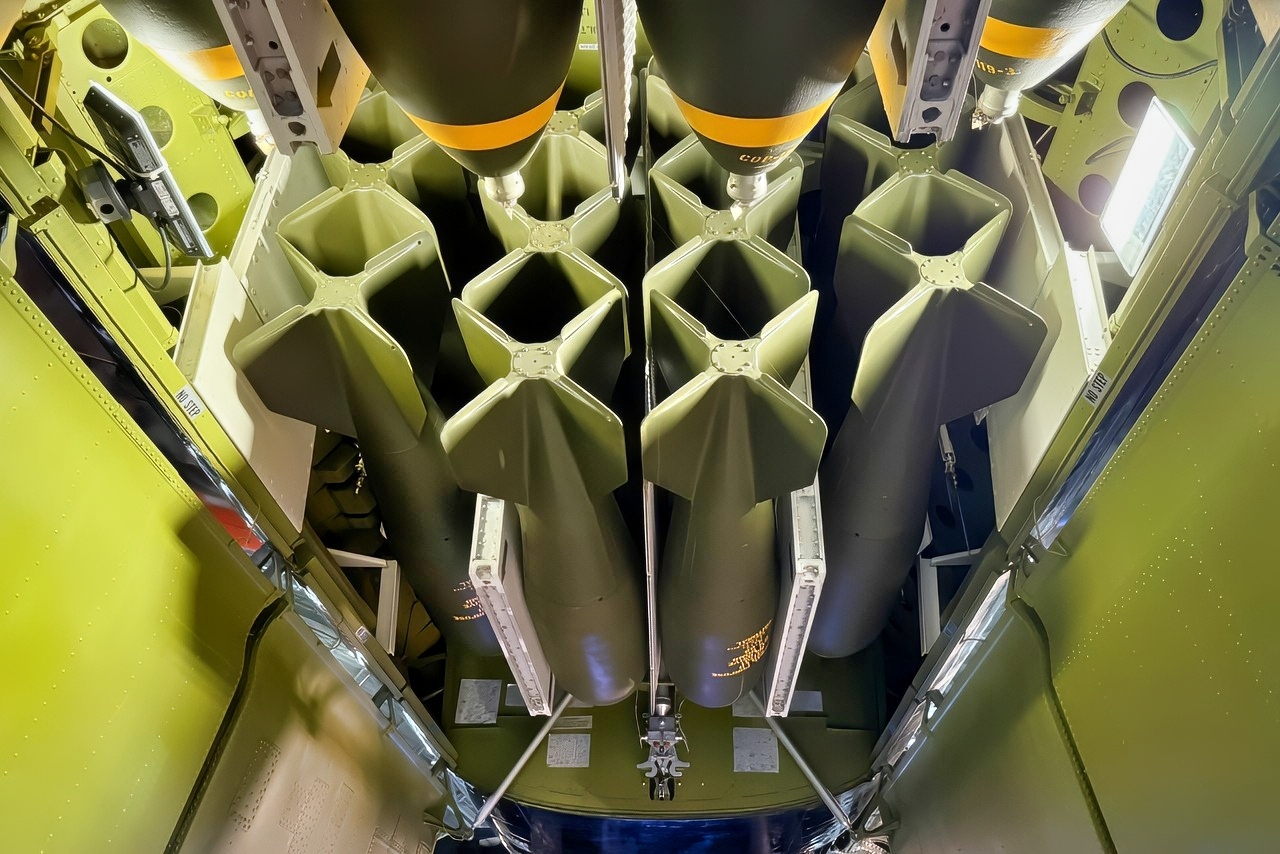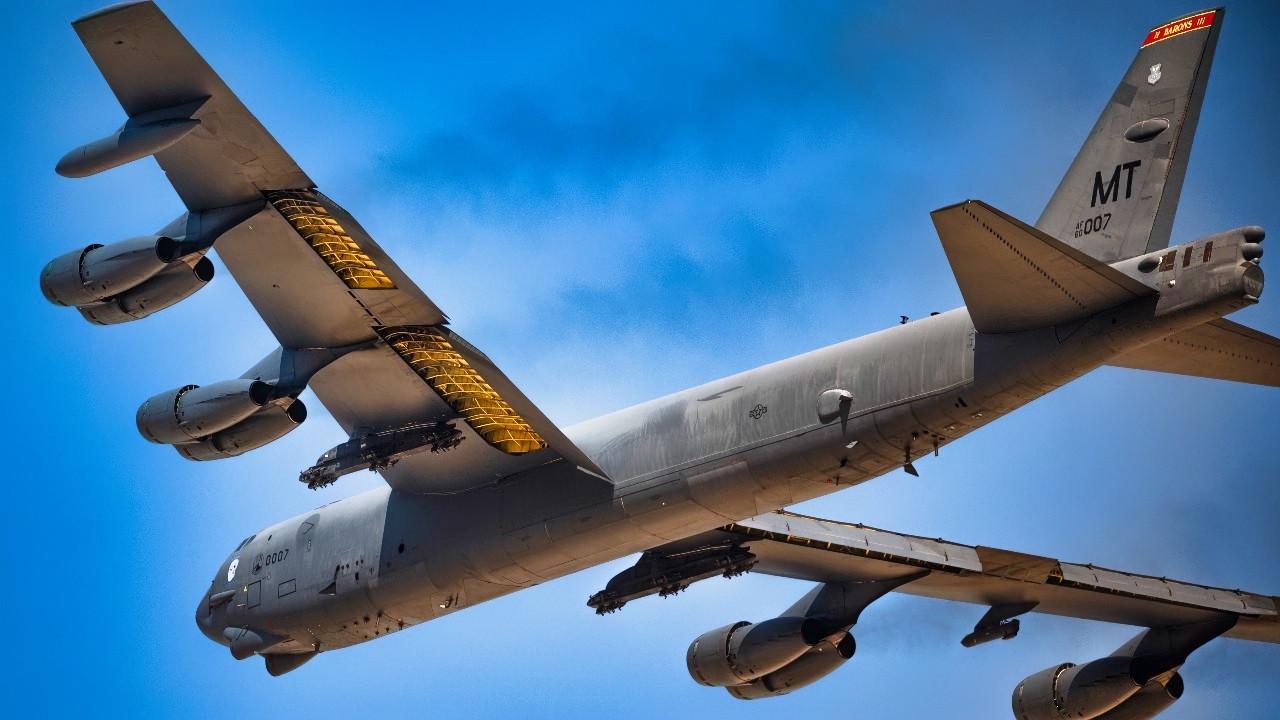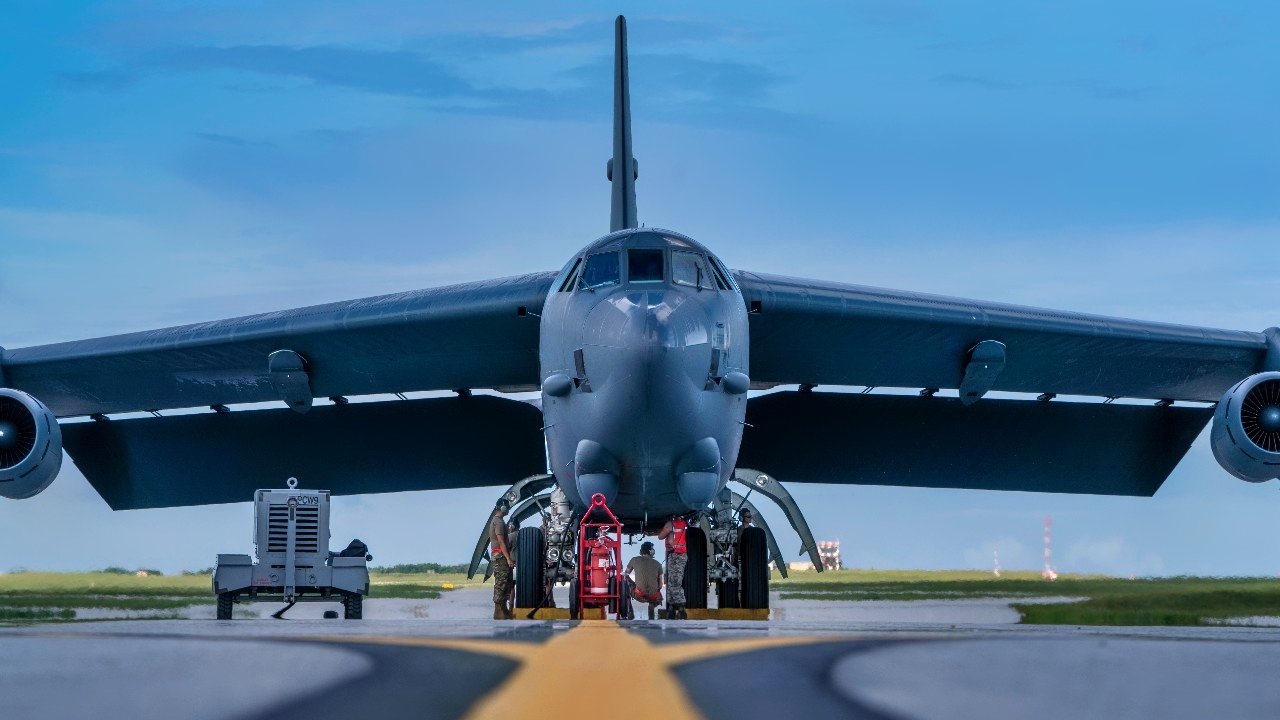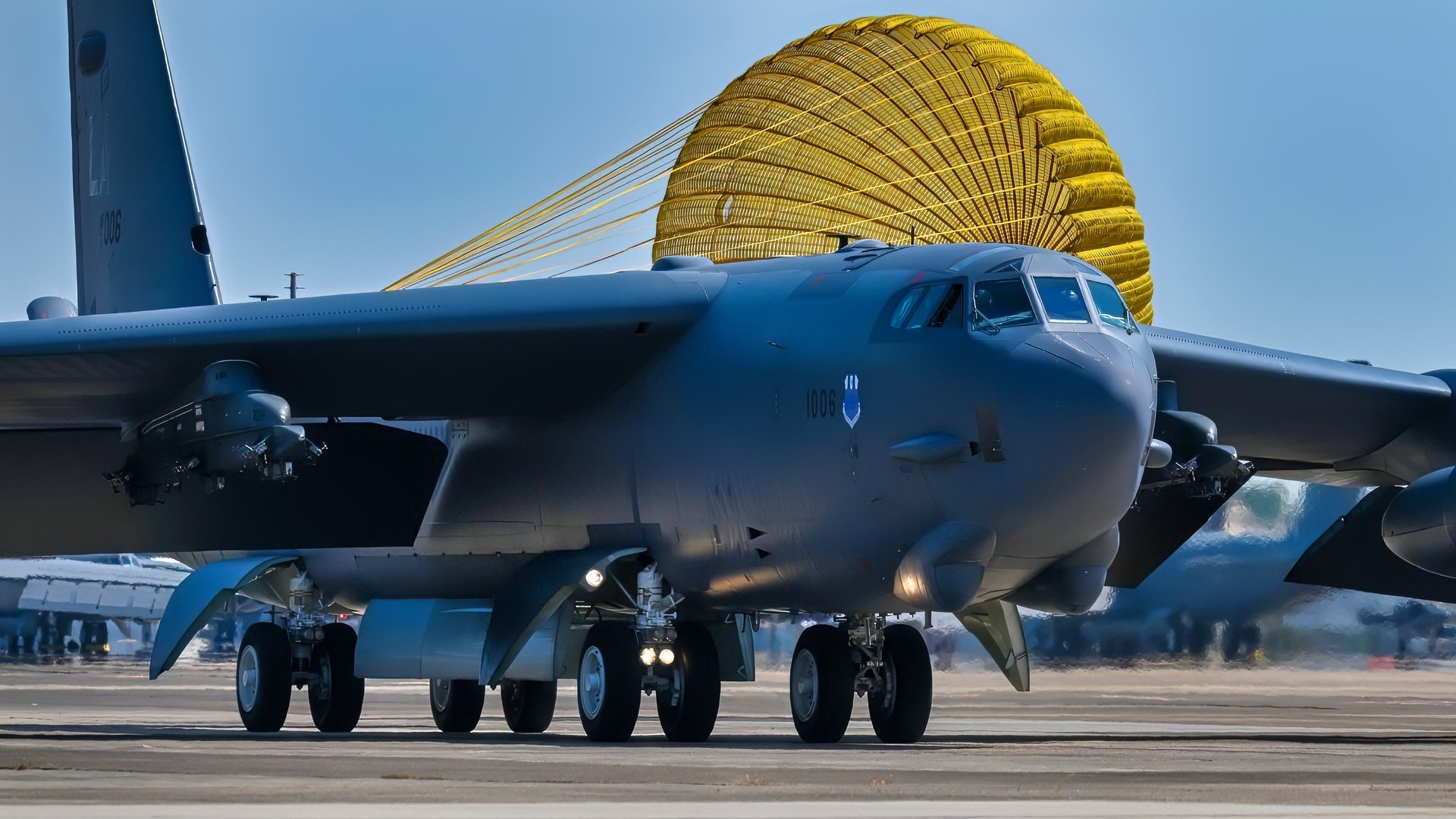Article Summary: B-52H: The Bomber That Refuses to Grow Old
-The B-52H is the apex of the Stratofortress line: turbofan efficiency, huge range, a cavernous weapons bay, and room for electronics that keep getting better.
-Born to carry nuclear cruise missiles and refined for precision conventional strike, it has flown from Vietnam’s last years to the wars against ISIS.
-Its life has been stretched by upgrades like a digital backbone, a new AESA radar, and an internal weapons bay that fits modern smart munitions.
-A re-engined, re-radared B-52J could push the bomber into the 2050s—but schedule slips, engineering changes, and cost growth mean the H-model remains the proven standard for now.
-BONUS: National Security Journal just visited a B-52 bomber at the U.S. Air Force Museum in Dayton, Ohio. We have included original photos and videos of that visit in this article.
B-52H Stratofortress: How the “H-Model” Became the Best BUFF—and Whether a B-52J Can Beat It
When I stood under the bomb bay of a retired B-52 bomber at the U.S. Air Force Museum this summer, I quickly understood why some consider this bomber the best to fly (see the video below).
Longevity means you earn a place in the record books and get to claim that crown. You don’t keep an airplane flying for six decades by accident. The B-52H Stratofortress didn’t just outlast its stablemates; it became the most complete version of the BUFF idea—long legs, big payload, and the electronics to make both matter in the 21st century.
Even now, as the Air Force works toward a re-engined, re-radared B-52J, the H-model is the benchmark. If the J arrives on time and on promise (two very big ifs), the BUFF will mark its 100th birthday in frontline service.
Until then, the B-52H is the best the line has ever produced.
Why the Air Force Wanted an “H” at All
Earlier B-52s—especially the D and G—proved the airframe’s potential for world-spanning missions and heavy bomb loads. But they carried thirsty turbojets and avionics that weren’t built for the look-down/shoot-down, cruise-missile era that was arriving fast.
The H-model answered both realities. Its eight TF33 turbofans traded smoke and fuel burn for efficiency and range, and the avionics architecture set the stage for long-range standoff weapons and, later, precision conventional strike. In short: the H kept the BUFF’s volume and endurance while making its energy and electronics far more useful.
What Made the H-Model Different
Three things turned the H into the definitive Stratofortress.
Engines that bought back the map. Swapping to TF33 turbofans yielded quieter, cleaner thrust and markedly better fuel economy than earlier J57 turbojets. That mattered for nuclear alert postures—and later for global conventional strikes—because tankers and airspace are always the limiting factors.
A design that welcomed missiles. The H was optimized to carry air-launched cruise missiles and later conventional variants, giving crews the option to strike from well outside dense air defenses. That standoff logic underwrites the BUFF’s nuclear relevance today and its conventional utility against modern SAM belts.

Bombs Inside the B-52 Bomber. Photo taken by Harry J. Kazianis/National Security Journal.
A chassis built to be modernized. The B-52H retains the bay space, power, cooling, and access that integrators need. Over time, that meant a digital backbone (CONECT), new radios, targeting pods, and an internal weapons bay interface—each upgrade compounding the value of the last.
How the H Kept Getting Better
The BUFF’s renaissance has been more “roll-on, roll-deep” than a single big bang.
Start with the CONECT architecture, which replaced much of the analog wiring and crew-station equipment with a digital network and human-machine interface that could ingest new sensors and weapons without months of rewiring. Add the 1760 Internal Weapons Bay upgrade, which moved smart weapons—JDAMs, JASSM/JASSM-ER, and MALD—inside the bay, freeing pylons for more or different stores and cutting drag on long missions.
Layer in an AESA radar to replace a maintenance-hungry Cold War set; beyond reliability, it improves mapping, tracking, and resistance to jamming—exactly what a standoff bomber needs to find, fix, and hit targets while staying emission-disciplined. None of these upgrades made headlines like a new airplane would, but together they made the H-model a very modern strike truck.
The H-Model at War
The B-52H’s combat story doesn’t start with Vietnam’s “Arc Light” era—that was largely the D and G. But once the Cold War ended, the H became the BUFF that kept showing up wherever the United States needed long-range precision and endurance.
During Desert Storm, B-52s fired the first conventional cruise missiles of the war from intercontinental range, demonstrating exactly why standoff matters. In Allied Force over Kosovo, H-models combined CALCM salvos with conventional bombing runs, leveraging their endurance to sustain pressure against a sophisticated integrated air defense system.
After 9/11, the BUFF’s mix of persistence and precision made it a staple over Afghanistan, where it delivered guided munitions in support of special operations teams and conventional forces alike. By 2016, B-52Hs were back in the Middle East striking ISIS targets, flying from Al Udeid and sending JDAMs with an efficiency that belied the airframe’s age.
More recently, Bomber Task Force rotations have put the BUFF over Europe, the Middle East, and the Indo-Pacific to signal reach, integrate with allies, and keep crews current on the long-haul playbook.
If you were writing a résumé for global strike, the H-model’s would be crowded.
The “Hidden” Advantage: Crew and Sustainment
Part of the H-model’s durability is social, not just technical. Thousands of maintainers know the airplane, its quirks, and how to keep sortie rates high with sane budgets. Crews inherit tactics refined over decades of joint exercises and real wars. And industry has learned (the hard way) how to integrate new kit on a 1960s design without turning every mod into a science project. In a budget world where certainty is value, the H-model is a known quantity that still moves the needle.
Enter the B-52J—On Paper, the Best BUFF Yet
If the Air Force can land the upgrades, the B-52J will be a meaningfully better bomber. The headline is the Commercial Engine Replacement Program (CERP): swapping the eight TF33s for Rolls-Royce F130 engines in twin pods. Expect big fuel-burn reductions, more electrical power, modern digital engine controls, and far better reliability and maintenance economics. Pair that with the new AESA radar across the fleet and cockpit display refreshes, and the BUFF gains detection range, mapping quality, and growth headroom for new weapons and electronic warfare tricks. The J-standard is also the on-ramp for the LRSO nuclear cruise missile, which replaces aging ALCMs and preserves the bomber leg of the triad against modern air defenses.
In concept, the J is everything operators like about the H—only cheaper to run, easier to fix, and sharper-eyed.
…But the J Is Running Into Real-World Problems
Re-engining a 60-year-old jet is not like swapping tires. The CERP team had to redesign inlets, nacelles, and struts to make modern engines play well on twin-pods under a BUFF wing. That’s driven rework and validation testing, along with schedule pressure. The radar modernization effort, meanwhile, has faced its own cost and integration churn as labs and contractors sort hardware, software, and flight-test sequencing.
All of this adds up. Independent watchdogs and service updates now indicate that the initial operational capability for the re-engined fleet is expected to be achieved in the early 2030s, accompanied by associated cost growth. None of that means the J isn’t worth doing—it is. But it does mean the H-model remains the only BUFF you can fight tonight, and probably for several more years than planners hoped.
Why the B-52H Still Matters—Even If the J Arrives
The B-52’s value is more than tonnage. It’s about time over target, weapons flexibility, and networked reach. A BUFF can loiter while a joint force builds a targeting picture; it can carry a mixed magazine that plays across the kill chain; and it can serve as a shooter, a launch platform for decoys, or a quarterback for other shooters depending on the day.
The H-model does all of that now. It will do it even better as the new radar rolls in and as mission systems continue to evolve. The LRSO will only amplify that logic: when penetrating with a bomber is unwise, penetrating with the missile from a BUFF becomes the smart play.
What Would “Winning” Look Like for the J?
A successful B-52J program would deliver three operational wins:
Range and Availability. F130s that slash fuel stops and maintenance hours, letting a smaller fleet cover more sky with fewer tankers and fewer unscheduled down days.
Sensing and Survivability Margin. An AESA that sees farther, tracks better, and resists jamming, paired with digital EW growth space—so the BUFF finds more, sooner, and survives longer at the edges of modern IADS.

A U.S. Air Force B-52H Stratofortress strategic bomber assigned to the 69th Expeditionary Bomb Squadron flies within the U.S. Central Command area of responsibility, Nov. 15, 2024. The B-52H provides strategic options and flexibility to U.S. and coalition senior leaders with the aircraft’s ability to employ a wide range of weapons with precision and deliver a decisive response to adversaries who threaten peace and security across the region. (U.S. Air Force photo)

A U.S. Air Force B-52H Stratofortress bomber, deployed from Barksdale Air Force Base, La., lands at Andersen Air Force Base, Guam, July 4, 2020. The B-52 flew the 28-hour mission to demonstrate U.S. Indo-Pacific Command’s commitment to the security and stability of the Indo-Pacific region. (U.S. Air Force photo by Master Sgt. Richard P. Ebensberger)
Weapons Relevance Through the 2050s. A platform ready to carry LRSO and the next wave of standoff effects without a multi-year avionics retrofit every time a new weapon arrives.
Do that, and the J won’t just extend the BUFF’s life; it will extend the BUFF’s usefulness.
The Honest Bottom Line on the B-52H
The B-52H became the best Stratofortress by doing the unglamorous things right: fuel economy that makes range real, avionics that keep pace, and a structure that invites upgrades.
It’s fought everywhere the United States has asked it to, carrying weapons—from dumb iron to smart cruise missiles—that match the moment. The B-52J could be better still, but its first test is simply to arrive: engines validated, radar fielded, costs controlled, crews trained.
Until that happens, the H-model is not a placeholder; it is the BUFF—still relevant, still feared, and still earning its keep.
About the Author: Harry J. Kazianis
Harry J. Kazianis (@Grecianformula) is Editor-In-Chief and President of National Security Journal. He was the former Senior Director of National Security Affairs at the Center for the National Interest (CFTNI), a foreign policy think tank founded by Richard Nixon based in Washington, DC. Harry has over a decade of experience in think tanks and national security publishing. His ideas have been published in the NY Times, The Washington Post, The Wall Street Journal, CNN, and many other outlets worldwide. He has held positions at CSIS, the Heritage Foundation, the University of Nottingham, and several other institutions related to national security research and studies. He is the former Executive Editor of the National Interest and the Diplomat. He holds a Master’s degree focusing on international affairs from Harvard University.
More Military
The B-21 Raider ‘Arsenal Plane’ Would Be Epic
China’s Aircraft Carrier Strategy: Stay Local, Stay Ready to Fight
Aircraft Carrier USS Theodore Roosevelt (CVN-71) Has A Message for Any Navy on Earth
Bad News for Putin’s Ukraine War: Russia Is Now Forced to Import Fuel
The Essex-Class Aircraft Carriers Have A Message for Any Navy on Earth










